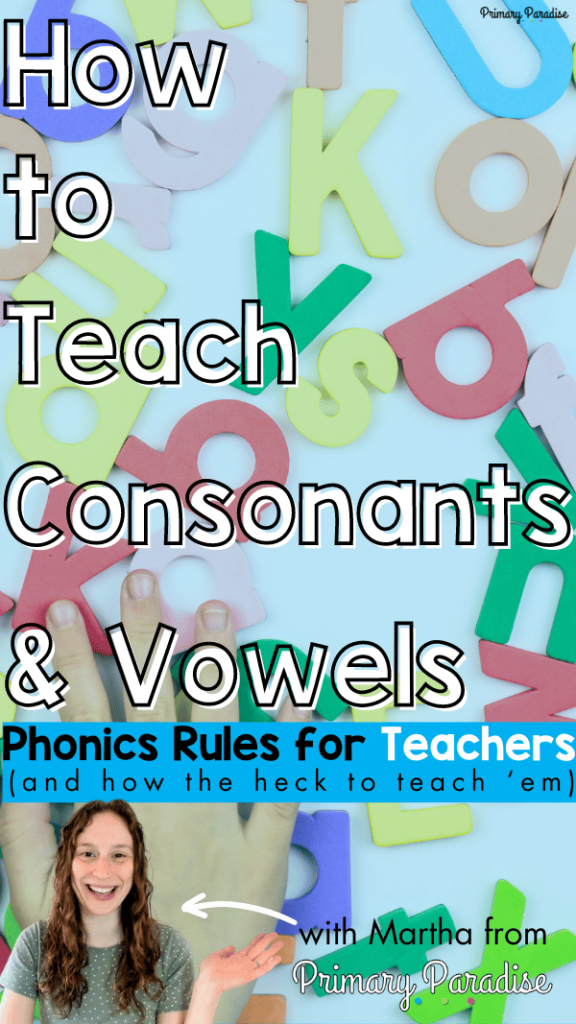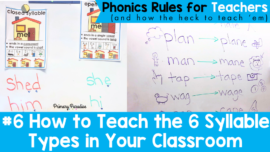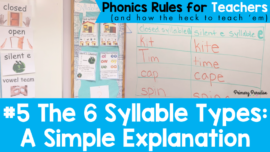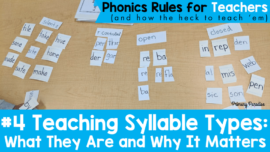Do you teach consonants and vowels to your students? Do you understand the difference between these two phonics concepts? Or why they matter? There’s a lot more to know about consonants and vowels than most teachers realized. Let’s dive deeper into the difference between consonants and vowels, how the impact English words, and how we can teach our students about this foundational phonics topic.
Would you rather listen or watch? Find a podcast version of this blog post here, or watch the video below.
A Quick Phonics Review
In my last post in this series Phonics Rules for Teachers (and how the heck to teach ’em), we explored the concepts of letter names and letter sounds. (If you missed that, be sure to give it a read here so you can fully understand today’s post.) All caught up now? Great.
As you now know, letter names are how we identify letters (what we say when we sing the ABC song). Letter sounds, or phonemes, are the sounds our mouths make when we read words. For example- the word bed has 3 letters- b, e, d. It also has 3 phonemes, or sounds- /b/, /e/, /d/. The word shark, however, has 5 letters- s,h,a,r,k but only 3 phonemes- /sh/, /ar/, /k/. Keep this in mind as we continue.
How to Categorize Consonants and Vowels

If I ask you to tell me the vowels, you’d probably say the names of these 5 letters- AEIOU. If you were feeling fancy, you might even say- and sometimes y. And, if I asked you to tell me the consonants, you’d probably say “all of the other letters”. This is both correct and not correct. While it is generally true that those letters represent vowel sounds or consonant sounds in words, we can’t just categorize the letters AEIOU as vowels, everything else as a consonants, and y as a weird middling and call it a day.
A New Way to Look at Consonants and Vowels
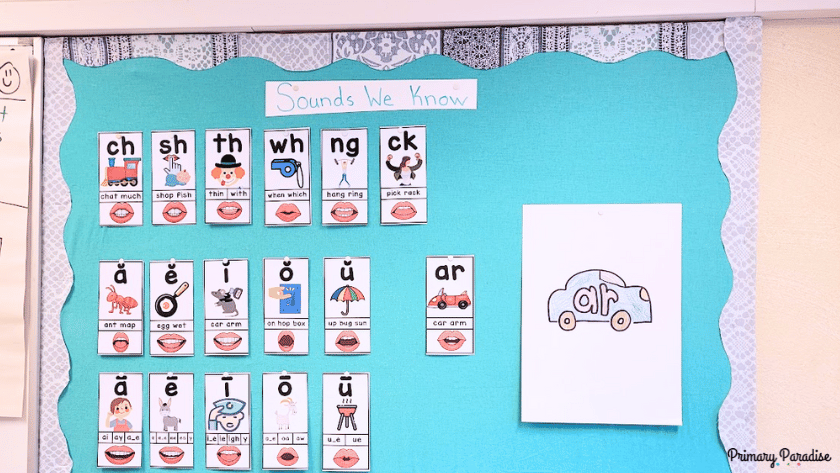
Vowels and consonants can’t only be connected to specific letter names because consonants and vowels are describing the sounds that letters represent. The best definition I’ve read for each comes from Uncovering the Logic of English: A Common Sense Approach to Reading, Spelling, and Literacy by Denise Eide. (Affiliate link: I receive a small compensation if you make a purchase at no extra cost to you.)
Eide writes that:
- A vowel is a sound that is produced when the mouth is open and the sound is not blocked by the lips, teeth, or tongue. Vowels are sounds that can be sustained.
- A consonant is a sound that is blocked by the tongue, teeth, or lips in some way.
In other words, when we make a vowel sound, our mouths are open and not blocked. Consonant sounds are made with the teeth, lips, or tongue blocking the airflow in some way. Don’t believe me? Right now, say all of the short vowel sounds and then long vowel sounds. The difference between consonants and vowels comes down to sound and not always specific letters.
The bottom line is this: if you can hold the sound out while singing and your mouth is open, it’s a vowel. If you can’t, it’s a consonant.
The Good News About This
Honestly, this is great news because it helps the English language make a lot more sense. If we assign the term “consonant” to certain symbols and “vowel” to certain symbols with no further explanation, it makes it really confusing that the w in snow is helping to represent a vowel sound and that the i in onion is representing the consonant /y/ sound. When we understand that vowels and consonants are sounds, English starts to make more sense.
A Crash Course on Vowels
English has 15 vowel sounds that can be spelled 28 ways. Vowel sounds can be spelled with one letter or multiple letters. Vowels that are spelled with more than one letter, are called vowel teams or vowel digraphs. Both of these terms are correct. It can just depend on the curriculum you use or where live.
Vowels are very important because every syllable must have one vowel sound. (Next week we’ll be talking about the basics of syllables and why they are so important). Since every word in English must be made up of at least 1 syllable, every word must have a vowel sound. If students know this, they’re less likely to write words without any vowels because they realize they have to have a vowel.
A Crash Course on Consonants
The English language has 24 consonant sounds. Most are spelled with a single letter, but a handful are written with multiple letters. Consonants can be grouped into three categories: unvoiced, voiced, and nasal.
- Unvoiced sounds– only the breath is used to produce these sounds. These sounds are represented by these letters- p, t, k, f, s, ch, sh, th (think), h
- Voiced sounds– the voice is used. If you put your hand on your throat while making these sounds, you’ll feel vibrations/movement. These sounds are represented by these letters- b, d, g, v, z, j, w, th (that), r, l, y
- Nasal sounds– the mouth is closed and the sound comes from the nose. These sounds are represented by these letters- m, n, ng.
Students don’t necessarily need to know these terms or categorize letters into these three categories. However, this is helpful information for some letters. For example, the digraph th can represent both a voiced and unvoiced sound. Which sound it represents can depend on the letters around it. Breath has an unvoiced /th/ sound and breathe has a voiced /th/ sound. The silent it makes the th voiced. I find it helpful to talk about voiced and unvoiced sounds when I’m teaching digraph th. And, so students understand that many consonant sounds are voiced and unvoiced, we make different consonant sounds with our hands on our throat to see which are which.
How the Heck to Teach It
Now that we’ve covered the difference between vowels and consonants, let’s take a look at 4 ways to make sure your students understand it as well.
1. Identify spelling patterns as consonant or vowel sounds

When learning a single letter or spelling pattern and the sound it makes, identify it as a consonant or vowel sound. When you’re first teaching single letter sounds, you can explain the name of the letter, the sound, and whether it is a consonant or vowel sound. For example, when learning about the letter P, you can discuss that P represents the /p/ sound and that /p/ is a consonant sound. P is a letter that represents a consonant sound. Students should know that a, e, i ,o and u typically represent vowel sounds. It’s just important to focus on vowels as a sound and not just a letter.
2. Daily sound drill warm up
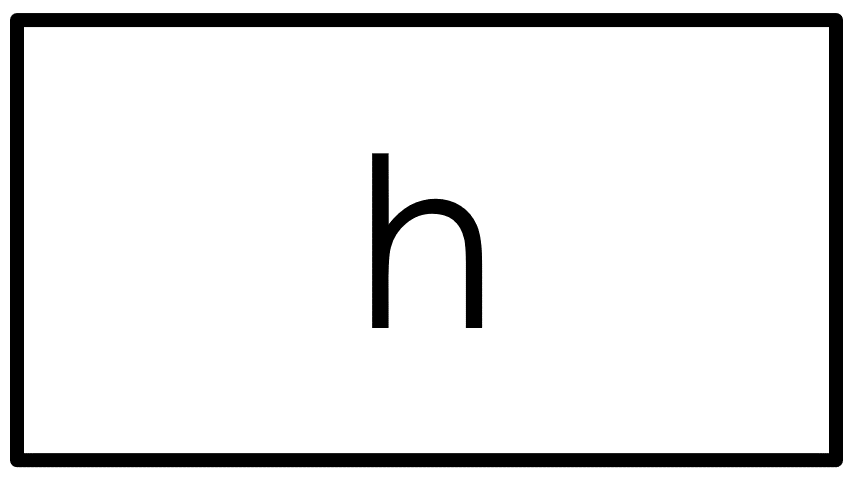
Each day at the beginning of your phonics lesson, take 2-3 minutes to do a sound drill with your students. Create a very simple Google Slides or PowerPoint and put one letter or spelling pattern on each slide. As you click through the slides, students produce the sound(s) the spelling patterns represent. You can either group vowel sounds and consonant sounds together, or ask your students to stand up for vowel sounds and sit for consonant sounds. As they learn new sounds, add them to the warm up slides. And, if a sound makes more than one sound, you can add a small 2 or 3 to indicate how many sounds that letter can represent. For example, S can represent /s/ and /z/ so once students learn both sounds, they can say both sounds for the drill.
3. Map words and identify vowel and consonant sounds

Word mapping, or simply matching letters to sounds, helps students learn words and connect spelling patterns to the sounds they make. It is a great strategy for developing reading and writing skills. Word mapping is also a great opportunity to focus on consonant and vowel sounds and what letters are representing these sounds in words. You can read an in-depth explanation of how to map words here. As you’re using this strategy, have students identify which letters are representing vowel sounds and which letters are representing consonant sounds.
4. Teach about syllables and syllable types

As I mentioned earlier, every syllable must have a vowel sound. If students know this, they are less likely to leave out vowels in their writing (example: writing hlp instead of help). Next week I’ll dive deeper into the basics of syllables, the types, and how understanding vowels and understanding syllables go hand in hand. But, teaching about syllable types is an excellent way to help students fully understand vowel sounds. It will also help them understand the rules and logic of the English language. This, of course, will help them develop into strong readers and writers.
Let’s sum it up
So, here’s what we’ve learned:
- When we refer to vowels and consonants, we’re referring to the sound letters represent.
- Vowels- open mouth, no blockage, sing it out.
- Consonants- the mouth is blocked in some way by the teeth, lips, or tongue.
- English has 15 vowel sounds and 24 consonant sounds.
- We can teach it by implicitly teaching if a spelling pattern represents a vowel or consonant sound, doing a daily sound drill, mapping words, and teaching about syllable types.
